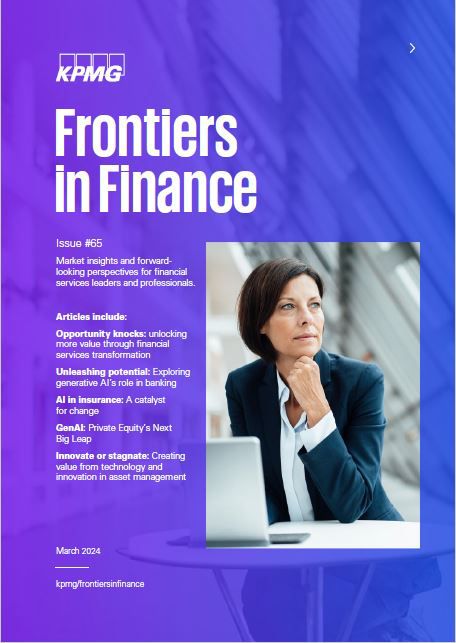Authors: Simona Scattaglia, Global Insurance Technology Lead, KPMG International and Partner, KPMG in Italy, Ilanit Adesman-Navon, Head of Insurance and Fintech, KPMG in Israel and James Henderson, Customer Insurance Director, KPMG in the UK
The insurance sector is built on the ability to manage risk and forecast the future. While many organizations are already transforming to meet the expected demands of both regulatory requirements and consumer needs, new and emerging technologies could offer a host of potential benefits to those that are willing to embrace change. Integrating these technologies could further enable precise predictions, manage customer interactions and expand the personalized service and product lines with unprecedented accuracy and speed. So, how prepared is the insurance industry to harness the latest technologies to help shape the future?
Many successful insurance companies are riding this wave. Some are adapting their product offerings and distribution methods — think comparison sites, Internet of Things (IoT) and usage-based policies.
Artificial intelligence (AI) isn’t new in insurance — existing use cases are seen across risk modeling, data forecasting, claims handling and contact center operations, with an abundance of potential opportunities in the pipeline.
Simona Scattaglia, Global Insurance Technology Lead and Partner, KPMG in Italy, highlights the promise and wide impact, “CEOs recognize that AI and Generative AI are technologies with huge potential for their business, because they touch on so many core aspects of what insurers do.
AI models can simulate future scenarios, enhance the accuracy of risk estimation and drive better pricing. They can also identify false claims more effectively. There are powerful AI applications for the
insurance industry and it will likely force innovation in many areas.” Yet, a reliance on legacy systems poses a challenge to innovation. While existing technologies provided the level of support previously required, and gave stability during the global pandemic to help insurers weather macroeconomic pressures, the same systems could now be holding them back. And with several tech giants intent upon disrupting the insurance market, it’s clear that traditional insurance products are struggling to keep pace with emerging customer lifestyles.
By integrating AI, innovation in insurance could find another gear. For many, the journey starts with centralizing data and transitioning outdated systems to cloud architectures. Aligning tech stacks and operations with the evolving needs of businesses, customers, partners, and distributors is ongoing, but the level of effort and investment are further signs that insurance products and services are ripe for innovation. However, insurance leaders should also be aware of the associated challenges and risks that accompany the technology and look at how to protect both the organization and consumer, by developing an understanding of the risk and action required to overcome these.
Leaping into the known unknown of AI
AI is evolving at pace, and there’s a lot to learn. That isn’t deterring insurers as revealed in the KPMG global tech report 2023 where 52 percent of respondents picked AI (including machine learning and GenAI) as the most important technology in helping them achieve their ambitions over the
next three years. The KPMG 2023 Insurance CEO Outlook also highlights a significant degree of trust in AI with 58 percent of CEOs in insurance feeling confident about achieving returns on investment within five years.

One reason for the rapid adoption of AI is an abundance of use cases. From back office to front office, insurance functions can see potential benefits in automating claims handling, enhancing fraud detection, and optimizing agent and contact center operations. For now, these tend to be human-in-the-loop processes — with potential to fully automate.
Ilanit Adesman-Navon, Head of Insurance and Fintech at KPMG in Israel, highlights how AI can be used to guide ‘next best offer’ in more sophisticated ways. Illanit says, “AI is a step up from just prompting agents to answer queries. AI can be trained to understand sentiment, empathize with the customer situation, then guide agents to the most relevant, personalized offers — all of which could be done in real time”.
AI adoption also benefits from the ease of use and accessibility. The insurance workforce is already accustomed to using low or no code apps, so it’s not a massive leap to see them using AI to augment tasks through AI colleagues and co-pilots. For instance, AI-driven chatbots and virtual assistants are streamlining customer queries and claims processing, providing quick and CX-friendly responses 24/7.
Case study: Driving customer experience
KPMG in Israel assisted a large insurance company to develop a customer contact solution. By utilizing a variety of AI techniques to reduce the number of calls from customers, the organization aims to improve customer satisfaction and increase the efficiency of agents. Using a using Natural Language Processing (NLP) and a classification algorithm, KPMG helped the client to analyze and then categorize calls to the support center. Many were insurance policy-related questions that represent quick wins. For example, queries about policy dates and whether children are covered. Overall, the analysis showed that many of the queries could be handled more effectively through a self-service solution. KPMG professionals are working closely with the insurance business to consider how an AI-based solution will enable customers to simply ask a virtual assistant question like “what is my life insurance coverage?” and “is my family covered?” to get answers quickly and conveniently. This provides a cost-effective way to answer queries the first time, while reducing call volumes and improving customer satisfaction. Waiting times for queries that require human input will likely be reduced and customer service agents can focus on customer queries that require human input.
Increasing customer convenience and engagement are key to loyalty in an industry where personalized experiences are most valued. But how AI will ultimately enhance productivity and performance, and deliver the benefits and ROI are still being understood.
Some of the unknowns include an equally game-changing emerging technology: quantum computing is the next frontier. This could revolutionize data processing and analytics. Matching its unlimited processing power with Generative AI learning could see insurers make complex calculations, solve problems, analyze data, assess risks and personalize products in real time.
Some insurers are even deferring investment as they believe AI might leap again in less than a year. It’s a dynamic picture and KPMG has a measured approach to technology investment that focuses on gaining momentum: Think big, start small, scale quickly. As James Henderson, Customer Insurance Director, KPMG in the UK, explains, “We help clients strike the balance between imagining the enterprise-wide possibilities and not biting off more than they can chew. Setting clear KPIs and success metrics up front are critical steps to get the most out of each AI use case — seeing the potential and pitfalls up front.”
Insurance and technology risks
Risks and challenges accompany each new technology. As a balance to AI’s huge potential, KPMG research reveals that CEOs are acutely aware of the hurdles. Ethical issues around AI decision-making and the absence of robust regulation are the most prominent concerns. KPMG’s 2023 Insurance CEO Outlook highlights that 52 percent of CEOs see these as highly challenging. And the tech report reveals that nearly two-thirds (64 percent) of respondents say that complex regulatory and tax developments have to some/greater extent made them feel less confident about investing in new technologies.
Over 72 percent of CEOs agree that AI regulation should parallel the rigor of climate commitment regulations, which have seen a steady increase in detail and volume. As Mark Longworth, Global Head of Insurance Advisory at KPMG International and Partner at KPMG in the UK, emphasizes: “A robust regulatory framework for AI is needed that’s proportional to the risks. Regulation should not stifle innovation but safeguard usage.”

Cybersecurity is another major concern for 85 percent of CEOs. Its evolving sophistication is reflected by the third of CEOs (32 percent) who are worried about increasing threats and the quarter (24 percent) who highlight vulnerable legacy systems. The KPMG global tech report also highlights that 63 percent of respondents either agree or strongly agree that improving cybersecurity and privacy will help them provide a loyalty-winning customer experience. Successful AI implementation hinges on high-quality data. Again, the KPMG global tech report reveals that better data management and integration have been the top benefits for 42 percent of respondents. They’re aware that data quality before cloud migration is key to effective AI applications, and that clean, well-organized data is essential for AI to ensure accurate, transparent and fair decision-making. This also links back to regulation as insurers with unstructured or fragmented data will face significant challenges in meeting new legislation and building trust in the market.
Lastly, insurers face risks around failing to collaborate with InsurTechs. Embracing ecosystems and platforms can help insurers adapt to market changes and even reduce the risk market disruption. The interplay between traditional insurers and InsurTech firms is vital for fostering sector-wide innovation and expanding coverage to underserved segments. Collaboration could also help steer insurance toward a more inclusive, customer-centric, data-driven and tech-enabled future.
People are the heart of innovation
As much as technologies reshape the world, people are the true drivers of change. Creating a culture of innovation is not just equipping teams with the right tools but also inspiring them to think creatively about how to use them. As insurance companies look at how best to leverage new technologies, part of the focus should be on talent management — developing a team with the right technical capabilities while empowering existing colleagues to upskill and help the workforce adapt.
Framing AI as a colleague, rather than a new technology, may help to remove the fear associated with roles being removed. For example, an underwriting virtual assistant could handle cases at a significant pace compared to the speed of a underwriter not using AI — and with potentially even greater accuracy. Integrating these AI roles alongside human colleagues will likely enable insurance functions to better manage complex tasks and focus on delivering additional value to the business.
Innovation cannot be the domain of specialized teams alone — making it part of the organization ethos is key. In practice, this could be setting up systems where feedback loops are integral and inform continuous improvement and adaptation.
It could also mean making transparency the norm or simply asking people what they need and encouraging everyone to contribute ideas. At the very least, it’s investing in training and development that help employees understand how to apply these new technologies effectively to benefit both personal and organizational productivity. Insurance companies are already transforming their operations, exploring new technologies and in some cases leading the charge on AI.
They also know that innovation is a journey that requires ongoing effort, investment, and most importantly, a willingness to embrace change at all levels of the organization. And beyond, to get closer to customers and build new business partnerships. While there are risks to every technology wave, the biggest risk could be missing the opportunity to shape what’s possible in insurance.
Best practices and next steps
KPMG firms have built best practices into a range of tools designed to get the most out of AI — all geared towards helping drive efficiencies, speed uptime-to-value and better connect technologies to business goals. In a nutshell, these are our recommendations:
Sprint to save faster: First, build internal and external confidence in AI and tap into KPMG firms’ experience to identify a process that’s ripe for change. Our technology alliances can help you quickly create a working example of AI in action. Plus, we can help you figure out savings, revenue and customer-experience KPIs.
Upgrade to accelerate delivery: If your transformation plan is up to three years old, it will need updating to keep control of costs and manage risks. Review current plans thoroughly and see where AI can add the most value while reducing the risk of failure. Adjust these plans to find extra cost paybacks and in-flight changes to delivery plans.
Re-imagine achieving value faster: Re-imagine your enterprise for a future where AI reduces costs and delivers value. Be prepared to disrupt and radically rethink structure in search of savings and new value sources. With the guidance of KPMG professionals and pre-built tools, create a step-by-step plan that will help speed up time-to-value.
KPMG Trusted AI
KPMG firms are excited about AI’s opportunities and equally committed to deploying the technology in a way that is responsible, trustworthy, safe, and free from bias. KPMG Trusted AI, is our strategic approach and framework to designing, building, deploying, and using AI solution in a responsible and ethical manner so we can accelerate value with confidence.
Contact your local member firm to talk through insights from this article, or to discuss your unique technology and AI requirements.

Frontiers in Finance: Issue 65
Market insights and forward-looking perspectives for financial services leaders and professionals.
Download magazine (1.9 MB)







